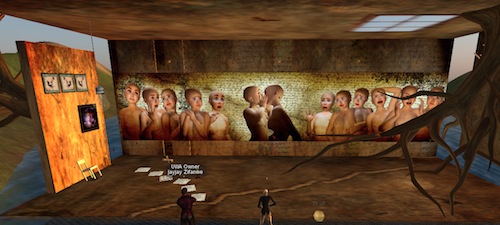You may have seen a story on New World Notes today about the removal of an installation from the 7th birthday celebrations for Second Life.
First, some context. The installation is titled Susa Bubble, and it looks like this:

(You can check it out for yourself in-world or you can view a higher-res pic here)
The creator, Rose Borchovski sums up the issue from her perspective:
The Kiss has been returned to me from the SL7B sims where Linden is celebrating Secondlife. I quote “The images on your build are in violation of our general rating, to be clear: Nudity is not allowed at art events with a general maturity rating.â€
I would like to point out and educate Linden Lab that most of classic and contemporary art is based upon nudity. Not because of Sex, but because of the beauty and the vulnerability of the human body, the human body we all share and look at in the bathroom mirror in the early morning.The story of Susa is a sweet but savage story, told in image and text, sound and installation. It is about our dark inside, but also shows how vulnerable and lonely we all can be. My art shows a naked body, but it is not about nudity or sex.
Art being shown at a public art event of Linden means pretty pictures that bring aesthetic pleasure void of all critical thinking. Culture must be “safe” / sterile, no matter how free of content that makes it. As implemented by LL, “Community Standards” means content so content less that no viewer has even a remote chance of being caused to think about anything, to question any of their values or assumptions. Safe in SL means safe from thought.
When I protested against it in the group chat I was shut out .I was told not to discuss it in SL7B Group Chat “because this isn’t the place” — because NO place is the place to discuss it — because we don’t even want to think or let others think about the ideas we don’t want to think about
The worst part of censorship is not that which is censored, but the climate of self-censorship it imposes on all artists. Art is about having a voice. Art is about thinking differently and about thinking from fresh perspectives. When artists are not allowed to have a voice, culture is not allowed to progress.
When I hide my susas nakedness, I have stopped telling her story.Nothing is more resistant to authoritarian control than a naked body. Control & conformity require uniforms. Nudity is too wild and uncontrolled. When you know my Susa Bubble story you can see it isn’t really even about “nudity” but that just suggests how powerful the forces for thinking-avoidance-at-all-costs are. Better to censor the world than risk allowing in a question that could topple the status quo. Authority does not like questions. Authority does not like creativity. Authority does not like art. Authority does not like nudity.
I did not bring my installation to the celebration to publicize myself, I make in art in SL because I want to share my Susa story and touch people
Greetings Rose Borchovski
Take another look at the picture above and then explain to me how it really qualifies as nudity? And remember, Linden Lab CEO Mark Kingdon has had his own art exhibited in Second Life. Sure, there needs to be some boundaries around what is acceptable but is it just me that finds that boundary to be just a little tight?
If you clicked on the SLURL above you will have ended up on the University of Western Australia sim which is now hosting the installation. Jayjay Zifanwe from UWA loved the installation and offered to host it, not in protest but in admiration of the work.
Which is the sort of collaborative attitiude Linden Lab could have adopted in their dealings with Rose Borchovski.
On top of everything else the Lab have been involved in over the past week – did this need to occur?
The final word belongs to Rose:
“It would be wonderful to take this oppertunity to have a fresh look at art and Second Life and what it means to Linden, to have so many artist creating”






Recent Comments